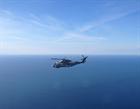Merlins submarine hunting in the Mediterranean
HIGH above the azure waters of the central Mediterranean a Royal Navy Merlin conducts a dawn patrol – for somewhere down there are two submarines lurking. Three of these helicopters from 829 and 814 Naval Air Squadrons based at Culdrose in southwest Cornwall as well as 75 supporting air and ground crew are the UK’s input to Proud Manta – the biggest anti-submarine exercise run by NATO.
Ships, submarines and aircraft from 14 nations have converged on Sicily for the two-week war game, with the Royal Navy detachment arriving at Sigonella air base close to Mount Etna.
In the most recent strand of Proud Manta, 814 scrambled a Merlin with the sun just rising above Europe’s largest and most active volcano, to hunt two submarines reported to have entered its area of responsibility. Heading out into the Mediterranean the Merlin crew began their search in earnest and were able to close in on an Italian submarine using their Active Dipping Sonar known as ‘Flash’. Effectively ‘cornering’ the submarine – not an easy task given the size of the Mediterranean – the Merlin showed its teeth as it swooped in for a simulated attack run.
“Going up against submarines is always difficult,” explained 24-year-old Lieutenant Hannah Best, an observer with 814 NAS. “They are extremely capable and often very hard to track, so when we find one it is a great achievement.” The helicopter crew managed to complete four simulated attacks on the Italian boat before heading back to base, maintaining the Royal Navy Merlin’s position as the most capable antisubmarine warfare and maritime patrol helicopter in the world. Lt Best, who only last summer was safeguarding the skies over Weymouth during the 2012 Olympics, added: “It’s always exciting when you are operating with real submarines; and working with the other nations in NATO is such a great opportunity and is of massive training benefit to us as aircrew.”
The submarines stalking in the Mediterranean aren’t the only challenge faced by the Culdrose fliers. The Royal Navy detachment arrived at US Naval Air Station Sigonella to find Etna was erupting for the first time this year. “Lava was shooting thousands of metres into the air as an ash cloud reminiscent of the one that covered much of Europe in 2010 spread over Catania,” said the detachment’s logistics officer Lieutenant Matt Culle. They were also greeted by a violent thunderstorm which transformed the streets of Catania into furious torrents - 50 litres of rain fell in every square metre in just 30 minutes. “I have never seen so much water flowing in a city - it was as if I was like driving through a raging river; as parked cars, bicycles and tables and chairs started floating passed. I reached the airfield just in time as the engineers did their best to protect the helicopters from the downpour,” added Lt Cullen. The weather was, of course, not going to get the best of the Merlin men and women. As the
sun came out, the water drained away and the volcanic ash blew clear of the airfield and the aircrews were back in the air to persue a Greek diesel-electric submarine in company with an American P3 Orion Maritime Patrol Aircraft. One of 829’s observers, Lt Karen Snel said: “It was a really successful first sortie for me – we established communications with the Americans and then opened up into our search area,” she said.
Proud Manta continues until the middle of the month as the Culdrose aircrews take their chances against their submarine foe. The detachment from 829 and 814 Squadrons will then fly back to Cornwall to share their experiences with the rest of the Merlin community as they return to their natural home operating from Royal Navy warships.

